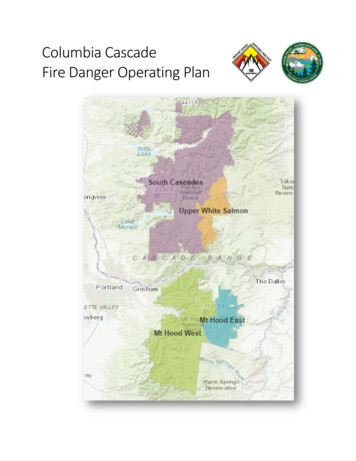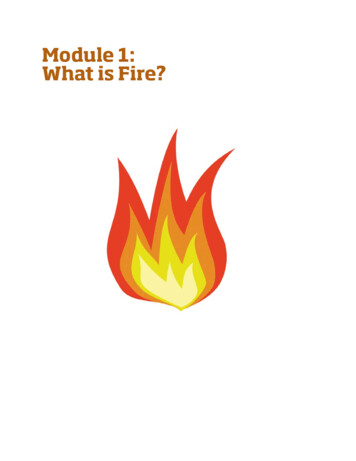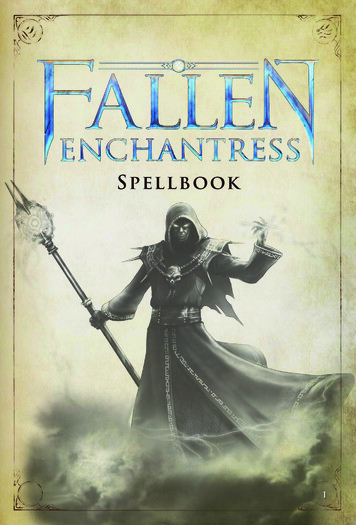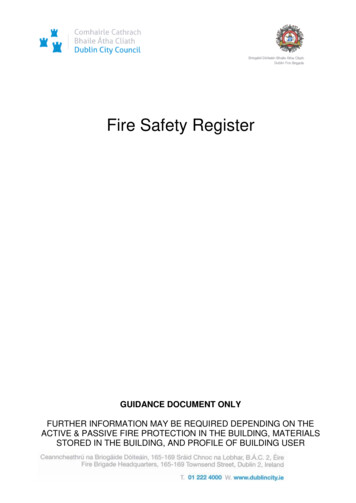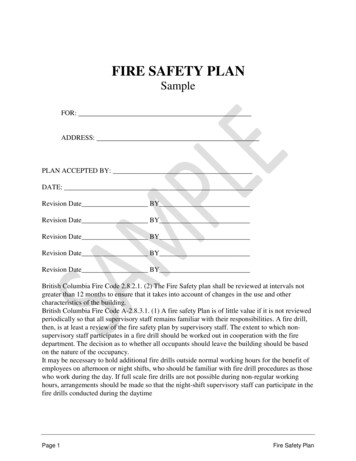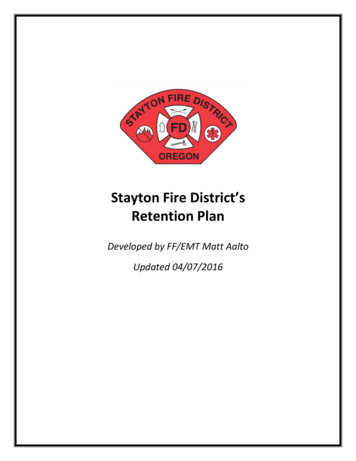
Transcription
Stayton Fire District’sRetention PlanDeveloped by FF/EMT Matt AaltoUpdated 04/07/2016
Table of Contents1. Recruitment/Retention Coordinator2. Current Retention Issues3. General Retention Themes4. Resident Volunteer Retention5. Membership Process6. Membership Establishment through Academy7. Academy8. Academy Graduation through Competency Completion9. Competency Completion through End of Probation10. Continuing Education11. Firefighter Health Program12. Training Incentives and Rewardsa. Pointsb. Completion of Academy/Fire Certifications/Medical Trainingc. Lost Wage Incentived. Training Scholarshipse. Tuition Reimbursementf. Resource Availability13. Volunteer Incentives and Awardsa. Bonus Bucksb. Incentivesc. District Awardsi. Rookie of the Yearii. Firefighter of the Yeariii. Support Person of the Yeariv. Officer of the Yearv. Medic of the Yeard. Support Volunteer Awardse. Length of Service Award Program (LOSAP)
Recruitment/Retention CoordinatorThe coordinator will maintain the operating retention plan for the duration of the grant unlessotherwise directed by the Chief. Year round recruiting and retention efforts will be a part of theDistrict’s long term success by bringing in new members and encouraging existing members to stayactive in the department. The recruit and retention coordinator will use the retention plan as aguideline to maximize existing materials, but will evaluate successes and failures of the plan on anongoing basis and make changes and amendments as necessary. The plan is specifically designed to beopenly evaluated as are the different programs adopted to support retention efforts. Both successesand failures of those plans will be documented for future review and evaluation to help understand whysome programs may have worked, and why others did not. Since this plan will be under constant review,changes may be updated before plans are officially in place, and some plans may be discontinued beforeofficially removed from this plan.A constant theme for the coordinator position will be the research and implementation of newrecruiting and retention concepts. The documentation of the successes/failures of these ideas and theirimplementation will be critical for their immediate and future uses. Successful ideas and techniques willbe implemented into their respective plans. Based on personal interviews, feedback, exit interviews, andoutside perspective, we will make every effort to evaluate our current plan and ensure that it is adaptingas needed to meet the ever changing needs of the district.An additional theme for the coordinator will be to communicate constantly with all firefighters, officersand support staff to evaluate how satisfied they are with their volunteer experience. Periodic surveyswill be conducted to isolate possible retention issues within the District, as well as provide thevolunteers with the opportunity to provide feedback for ways the District can improve the volunteeringefforts. All of these results will be made available to the respective chief officers for use at theirdiscretion.Current Retention IssuesIn looking at our length of service data, we recognize certain points of significant attrition occurringbetween 5-11 months, 2-3 years and again around 5 years. After conducting member surveys and exitinterviews for past members we learned that the members that left after several years of service quitbecause of lifestyle changes (moved, job change, family change) while members that left before the endof their probationary period left because they didn’t understand the expectations of membership whenthey joined or became frustrated by a lack of direction. Others voiced concern regarding not beingutilized, or being bored while on shift. It is the Districts goal to provide a clear explanation of the dutiesexpected by the District, and in return a clear plan for their success and support throughout their fireservice career.
General Retention ThemesAs we address retention at the Stayton Fire District, a methodical approach will be utilized to focus onkey critical stages in the life of a volunteer firefighter. Different ideas, strategies and benchmarks will bediscussed to ensure that the past, present and future volunteers of Stayton Fire feel like they are anactive involved part of the District. As we go through the different phases of a volunteer’s lifespan,several items specific to that timeframe will be discussed. Retention lies not only in incentives andperks, but in a culture and atmosphere of respect, accountability and professionalism. These universalthemes will be carried out at all levels of the District. The plan relies heavily on increasedcommunication within the District, officer level training and a District-wide culture of continuingeducation. It is important to understand that retention is critical in the beginning of a volunteer’s career,but equally important as those volunteers become more experienced and want to learn new skills andbe continually challenged. The retention coordinator will continue to evaluate and recommend changesto ensure that this plan acts as a living document to meet the needs of today’s and tomorrow’svolunteers.Resident Volunteer RetentionResident Volunteers are provided with room and board, inclusion in the points system and continuingfire education as compensation to its residents. Daily duties and station responsibilities will bedistributed to assist the resident to understand the career track and general job expectations of a careerfirefighter. Residents will be offered the same opportunities as all other members including an assignedofficer.Currently, a program is in place that offers an incentive for resident volunteers which provides amonetary supplement and is built into the annual budget to increase recruitment and retention for thissegment of our membership.Membership ProcessAs the candidate begins the membership process, communication remains critical. Prompt processingof a candidates application, including a reference check, will be completed as soon as possible.Providing that no red flags appear in the candidates reference check, the candidate should be notifiedand scheduled for the next Board of Review (BOR).After the BOR is completed the results will be forwarded to Chief. Candidates should be informed at theconclusion of the BOR that the Chief will inform them as soon as possible of the Board’s decision and toschedule a Chief’s Interview. Pending the results of the Chief’s Interview, the candidate will bescheduled to begin their membership paperwork process as soon as possible.
While the candidate is going through the membership process, he/she will be encouraged to attend asmany weekly drills as possible. This encourages contact with current members that will help thecandidate feel more comfortable within the District and allow current members a chance to get to knowthe candidate. They will continue to have a mentor assigned to them during these drills and beintroduced at the pre-drill briefing.Membership Establishment through AcademyThe length of time from the candidates’ initial membership and the start of the next academy can be ahigh risk for turnover period. If the new member is facing a window of several months before the nextacademy, he/she will need to begin an initial level of training so that they can participate on a drillground. This will not only enable recruits to interact on drill nights, but will allow familiarity to trainingmaterial when it is presented during academy.Early introduction to a recruit’s officer will allow the recruit to establish a rapport, and give them anappropriate contact in the chain of command. The officer should hold them accountable to drillattendance, notify them about volunteer events, participation standards, and begin working on theircompetencies. The candidate should be aware at this point of the attendance standards and should beencouraged to attend as many drills as possible to meet the members and work on their skills.The recruit should have a meeting with the training officer to talk about training issues and to develop atraining plan for the recruit. For those new members that face a significant gap until the start of thenext academy, monthly competency trainings are recommended. These trainings will be organized bythe training officer and be held either on non-drill weekdays or weekends. These trainings will focus onintroducing the recruit to basic fire ground functions so that they are familiar with them and have afoundation of knowledge that their officer can build on at drills.AcademyWhile the recruit is in academy, he/she will still be encouraged to attend as many drills as possible. It istaken into account that the time demands on academy students are already significant, so the trainingofficer will determine the minimum number of required drills. Their continued attendance at drillsencourages further recruit contact with their officers and the general membership until they graduatefrom academy.Officers should be available to recruits throughout academy to help them study and assist withpracticing hands-on skills. This can be accomplished on a one-on-one basis, or by establishing a weeklystudy group led by a senior firefighter or higher. These groups are not meant to serve as make-upclasses for individuals who have missed classes but to help augment classroom time and make recruitsproficient at skills.
Academy Graduation through Competency CompletionIt is important at this stage of the recruit’s growth in the District that their competencies be completedas soon as possible. Therefore, the District requires this to be done within 60 days of graduation. Theresponsibility for accomplishing this will fall on the recruits shoulders, but officers and senior firefightersshould be prepared to make themselves available as much as possible in the weeks following thecompletion of academy to assist with this. Firefighters/Officers should be made available on drill nightsto take an engine to the training facility separate of the scheduled drill lesson to assist recruits withcompleting their competencies and relieve some of the time burden on officer’s personal time.As soon as the training officer is presented with the recruits completed competency task book, therecruit will be eligible for response. It is recommended that the recruit have a meeting with the trainingofficer and/or their officer to discuss how their training has progressed and where they would like to gowith it. They can also allow the training officer insight into the successes and failures of the academyand the recruit’s transition into a responding firefighter.Competency Completion through End of Probation:Upon successful completion of the probationary period the recruit will have a meeting with the trainingofficer at which point their drill attendance, response percentage, event attendance, performance andattitude will be evaluated. If the training officer determines that the recruit has performed adequately,the recruit will be awarded with an apparel award and will no longer be on probation.The training officer should utilize this interview as an opportunity to get the firefighter’s perspectivefrom a retention standpoint. Training, volunteer career goals, positive experiences and frustrations canbe discussed to provide constructive feedback for the District that can be utilized at this pivotal point ina volunteer’s career.The District’s insurance plan will also go into effect once the firefighter becomes a member of theDistrict. As part of this benefit, the firefighter will have a brief orientation to ensure they understandthe benefits and guidelines of the program and how to access it.Continuing EducationA major component of addressing short and long term retention issues will be the District wideemphasis of continuing education. By addressing this we will not only encourage our members to bebetter firefighters and increase our response level, but also provide firefighters and officers withtangible goals to achieve. By setting goals and monitoring members’ progress in achieving them, we canavoid the plateau that can occur at various points in a member’s career. Continuing educationbenchmarks will be included throughout the firefighters own development plan. When possible,financial assistance will be made available to the firefighter to assist in loss of wages and or assistance tocompensation for approved classes.
Firefighter Health ProgramAs cardiac failure remains the leading cause of LODDs (Line of Duty Death), our firefighters’ quality of lifeand ability to decrease their risk of succumbing to a cardiac event is an ever growing concern. Membersare encouraged to utilize the exercise equipment provided at no cost to members and immediate family.Training Incentives and RewardsPoints: The point system is available for review in the current Policy Manual and Orientation Manual.Completion of Academy/ Fire Certifications/Medical Training: An incentive plan is in place to rewardvolunteers for furthering their fire service knowledge. The Length of Service award program will offergreater detail. This information can be found in the Orientation Manual.Tuition Reimbursement: Members applying for the tuition reimbursement will have to meet thedistricts minimum drill requirements (see district policy manual). The members will need to fill out atraining request for review and approval by the Training Chief. Applications will be accepted for tuitionreimbursement at the private school or college level. Applications will be subject to final approval bythe training officer and the Chief.Resource Availability: A training resource book has been created to help district members locate fireand or medically related courses and understand the means for registering. A Training resource sectionis available on the districts website providing links to important training sites and information on howmembers can access important mailing lists for advanced notice of upcoming classes.
Volunteer Incentives and Awards (Support Staff awards may vary) Bonus BucksBonus Bucks will be given out in a value of 5.00 per buck. (See Bonus Bucks Program Guide fordetailed information). Bucks that are earned can be used for in house clothing and equipmentsupplies, or award recipients can redeem bucks on a reimbursement program. In-House TrainingWhen possible and depending upon availability, the District will seek outside special speakersfor motivation and leadership education. This may act as a replacement to the lost wageincentives if members are unable to get time off to travel for out of district training orleadership opportunities. ApparelCustom District items like Jackets will be provided when possible by available funding. Exercise equipmentThe health of our members is of utmost concern to both them and us. Many of our memberspay for an outside gym membership to take advantage of equipment not currently offeredthrough the district. There are several pieces of equipment that have been requested but themost asked for has been for a stairclimber. We currently do not have equipment that emulatesthis task yet our jobs require these muscle skills and cardio. Every year we also have a Stairclimbteam that trains for an annual event, yet in our community we do not have any buildings largerthan 5 stories. Because of this, the team and all other members must travel 60 miles to asuitable facility. By providing the equipment our members want, we are supporting a healthylifestyle, weight loss and muscle development which makes people feel better, work longer, andprevent injuries. PicturesWe currently have a large group of firefighters that have tenure with our organization. Wewould like to encourage them to become re-motivated and energized into spending more timeat the station. We would like to purchase picture frames and add pictures from drills or eventsor previous calls that can be hung in the members respective stations that include both themand the other members of their station. Some pictures we would like to offer as awards foroutstanding service on a call or for more general means like going above and beyond for theirdepartment or community, or chairing special events. We would plan to make a bulk purchaseof picture frames so they all looked alike, then print out our photos. We would make the optionof rotating or updating photos possible with just the print of a new photo to fill the spot.
Incentives in the first 18 months – or after Firefighter completes probation Candidate for Rookie of the YearCandidate for Medic of the yearCandidate for Green CrossTraditional HelmetName Tag for Dress UniformsCollar BrassBadgeLENGTH OF SERVICE AWARD PROGRAM (LOSAP)A. 100.00 per year of service up to twenty (20) years of serviceB. 200.00 per year of service from twenty-one (21) and thereafterC. *Eligible award benefits shall be distributed upon the death of an eligible volunteer tohis/her beneficiary.D. All awards are subject to IRS reportingE. The Fire Chief shall administer the program 5-40 Years of ServiceDuring this period, the firefighter qualifies for the following awards: 5 Years7 Years10 Years15 Years20 Years25 Years30 Years35 Years40 YearsFire Maltese Service ClockFF Bust StatueFire Service RingSteamer Desk SetLeather HelmetMantle Grandfather ClockFire Department Trumpet SetChrome Plated Axe w/Engraved HandleAward TBD
District Firefighter AwardsAwards offered for outstanding service to the District. It is not a guarantee that every award isgiven out each year as the merit of earning the award is based on multiple factors includingbeing nominated by peers, and evaluation by both the Chief and Assistant Chief. Each recipientof the respective awards will receive a plaque and coat. Awards are as follows: FF of the YearRookie of the YearSupport Person of the YearOfficer of the YearVolunteer Service with PrideSupport Volunteer AwardsAwards are offered to Support Staff who have served in good standing for specific length ofservice increments. The awards are as follows: 5 Years7 Years10 Years15 Years20 YearsMaltese Cross ClockFF Bust StatueEagle StatueTBDSteam Fire Pumper in Acrylic on Base
Year round recruiting and retention efforts will be a part of the District's long term success by bringing in new members and encouraging existing members to stay active in the department. The recruit and retention coordinator will use the retention plan as a . As we address retention at the Stayton Fire District, a methodical approach will .



